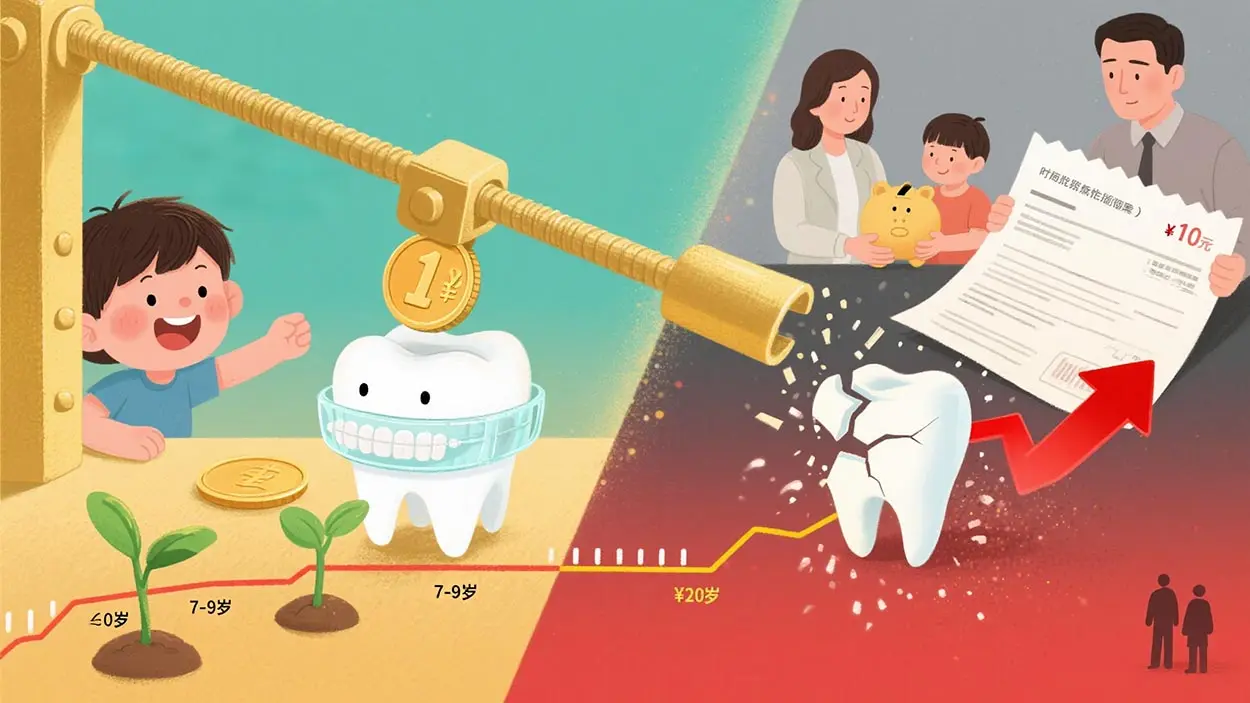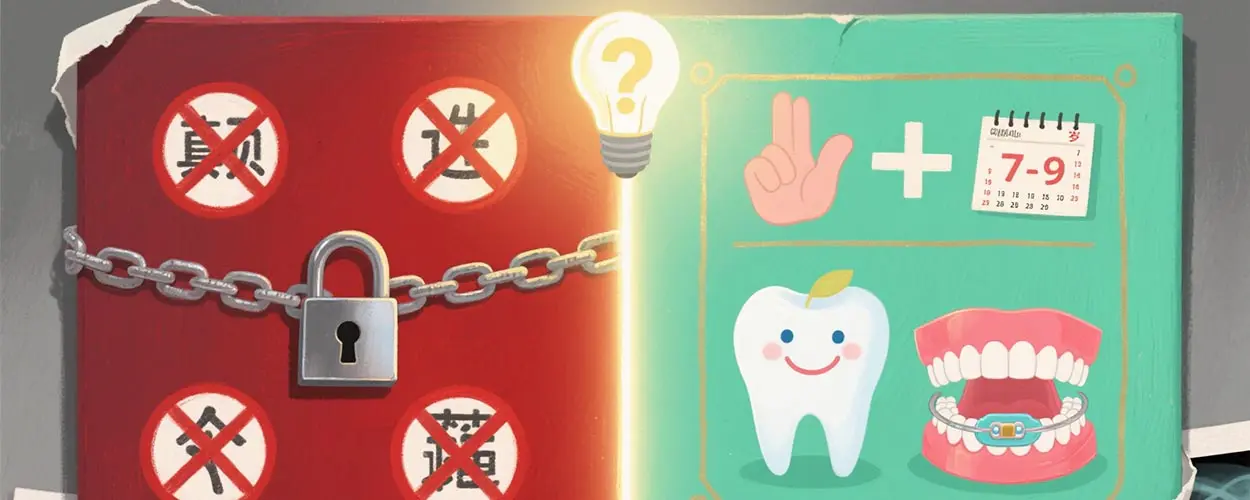Introduction: A Mother’s Regret
“If I had known earlier, my child wouldn’t have suffered.” ” This is Ms. Li’s sentiment. Her 10-year-old daughter was ridiculed by her classmates for having an underbite. During the examination, it was found that her lower jaw was severely protruding and she needed orthognathic surgery. The 7-year-old boy Mingming from the neighboring house successfully corrected the same problem through an MRC orthodontic appliance in just one year, and the cost was less than one-third of that of surgery.
When exactly is the “golden window” for children’s orthodontic care? How can complex treatments in adulthood be avoided through early intervention? This article uses real cases and authoritative data to reveal the answers that parents care about most.

1. Ages 7-9: The golden period for orthodontic treatment. How much does missing it cost?
Authoritative advice: The American Association of Orthodontists (AAO) points out that 7 years old is the key age for the first orthodontic examination. At this time, the deciduous and permanent teeth alternate, the growth activity of the jawbone reaches 80%, and the orthodontic efficiency is more than twice that of adolescence (AAO, 2022).
1). The “golden remodeling period” of the jawbone: a growth force of 0.1 mm per day
growth rate : The mandible of children aged 7 to 9 grows by 1.2 to 2mm per month (equivalent to three times the growth rate of adults). At this time, if problems are detected early, they can be easily corrected and recover quickly.
2). The “Navigation Function” of deciduous teeth
The idea that 90% of parents ignore the role of their baby teeth, believing that they will eventually fall out and that they don’t need to worry about the problem of baby teeth is wrong. Data surface
Premature loss of deciduous teeth : Premature loss of deciduous teeth can increase the rate of permanent tooth misalignment by 58%. For instance, 7-year-old girl Jenny lost her deciduous molars prematurely without intervention, which led to her permanent teeth tilting. Eventually, she needed dental implants to fill the gap.
underbite of deciduous teeth : If not corrected, the probability of underbite of permanent teeth reaches 92%.
3). The hazards of mouth breathing in children
Long-term mouth breathing can lead to “adenoid face” – a sunken midface and a narrowed dental arch. A study by Guangzhou Dental Hospital shows that correcting mouth breathing habits before the age of 7 can improve the rate of abnormal facial shape by 89%. However, if no intervention is made, after the tooth replacement period, surgical correction will be the only option, and the recovery time and financial cost will increase exponentially.
Case comparison:
| Patient | Intervention Age | Problem Type | Treatment Plan | Treatment Duration |
|---|---|---|---|---|
| Xiaoming (Intervened) | 7 years old | Mandibular retrognathia | Functional appliance | 18 months |
| Xiaomei (No Intervention) | 12 years old | Skeletal mandibular prognathism | Orthognathic surgery + orthodontics | 4 years |
Scientific basis:
Bone plasticity: The growth rate of the jawbone is fast at 7-9 years old. With orthodontic appliance guidance, the efficiency of bone remodeling is increased by 60%.
Avoid tooth extraction: Early arch expansion treatment can increase the width of the dental arch by 4-6mm, it can reduce the need for permanent tooth extraction by 70%.
2. Four core benefits of early correction
1). Health benefits: Only with good teeth can one enjoy eating and maintain nutrient absorption
- Chewing efficiency : The food grinding ability of children with malocclusion is reduced by 40%, and the nutrient absorption rate increases by 30% after correction
- Disease prevention : People with crowded teeth have a three times higher risk of developing dental caries than those with normal teeth, and the incidence of periodontitis decreases by 55% after orthodontic treatment.
- Case : A 9-year-old girl named Xiaowei had three permanent teeth decayed due to crowded teeth, which prevented some of her tooth surfaces from being cleaned properly. After invisible orthodontics, the brushing time was shortened from 10 minutes to 3 minutes, and the dental plaque index dropped by 80%.
2). Appearance level and psychology: Neat teeth make children dare to laugh heartily
- Appearance anxiety: 68% of children with misaligned teeth dare not show their teeth because they are ridiculed, and their participation in social activities increases by 90% after orthodontic treatment
- Maxillofacial coordination: Early intervention can adjust the proportion of facial features, increasing the length of the lower one-third of the face by 5-8mm for those with a receding lower jaw, significantly enhancing the three-dimensional effect of the side profile.
3). Economy: one early input is greater than ten adult remedies
Orthodontic treatment during the window period when teeth are not fully developed before a child’s tooth replacement only needs to address minor issues and can ensure a perfect outcome. However, if this period is missed, a great deal of time and cost will be spent dealing with major issues, and a good outcome cannot be guaranteed.

3. The overlooked “invisible killer” : These habits are ruining children ‘s teeth
1). Biting fingers, sticking out tongue
- Data: Children who bite their fingers for more than 2 hours a day have a fourfold increased risk of opening and closing their front teeth.
- Case: An 8-year-old boy in Chengdu had his upper teeth protrude by 5mm due to long-term biting of his lower lip. The correction was made after 6 months of lip muscle training and a removable orthodontic appliance.
2). Chew on one side
- Consequence: Long-term unilateral chewing can lead to facial asymmetry, with the width difference between the left and right sides of the face exceeding 3mm.
- Self-test method: Have the child stand naturally with their eyes closed, and the parent look down from above to observe whether the earlobe is perpendicular to the acromion.
3). Incorrect feeding methods
- The hidden danger of using baby bottles for children over 2 years old
- Research evidence : Children who still drink milk from a bottle after the age of 2 have a 2.3 times higher rate of anterior tooth underbite than normal children.
4. What Parents Must Know: 3 Steps to Avoid Orthodontic Pitfalls
1). Early Screening at Age 7: Identify Warning Signs
- Red Flags: Premature loss of baby teeth, mouth breathing, thumb-sucking, or jaw deviation.
- Diagnostic Tools: Panoramic X-rays and lateral cephalograms to assess jaw development (e.g., evaluating ANB angle).
2). Choose the Right Specialist: AAO-Certified Orthodontists
| Qualification | Training Duration | Ability to Handle Complex Cases |
|---|---|---|
| General Dentist | 0-6 months | Simple alignment only |
| Orthodontist Specialist | 2-3 years | Skeletal deformities, surgical adjunctive treatment |
3). Technology Selection: Match Needs, Avoid Trendy Options
| Type | Applicable Scenarios | Pros and Cons | Cost Range (USD) |
|---|---|---|---|
| Traditional Metal Braces | Severe crowding, skeletal issues | Strong effectiveness but noticeable | 5000 – 12,000 |
| Invisible Aligners | Mild to moderate misalignment | Aesthetic, but requires high self-discipline | 10,000 – 30,000 |
| Functional Appliances | Jaw development abnormalities | Requires full-time wear | 3,000 – 9,000 |
5. Controversy and Truth: Debunking 4 Major Misconceptions
- “Don’t worry about misaligned baby teeth” : Baby teeth are the guides of permanent teeth. The misalignment rate of permanent teeth in cases of baby tooth underbite exceeds 90%.
- “The earlier the correction, the better” : Intervention before the age of 4 May damage the tooth germ and requires professional assessment.
- “Invisible orthodontic omnipotent” : Severe bony problems still require brackets and bone screws.
- “tooth loosening caused by orthodontic treatment” : Under scientific force application, alveolar bone can regenerate, anda loosening degree within 0.2mm is considered normal

Conclusion: Invest in the future, starting with orthodontics
What I regret most is waiting until my child “grows up to talk about it”. This is a lesson for millions of parents. Early orthodontic treatment is not only about restoring the alignment of teeth, but also a long-term investment in a child’s health, confidence and future. A check-up at the age of seven might rewrite a child’s life script.


